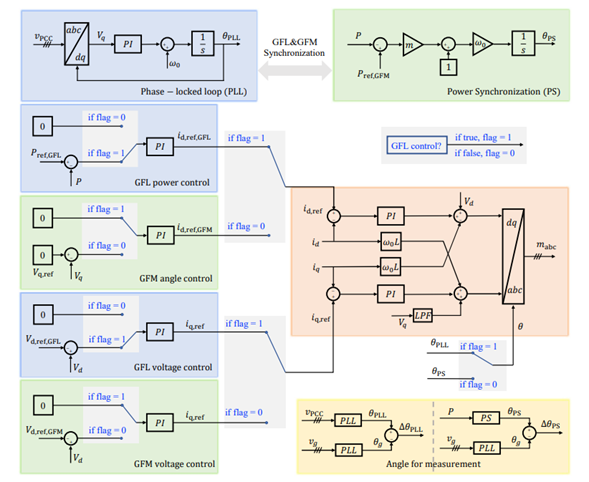Advantages
- Achieves easy retrofitting from the conventional grid-following control design, by using the same sensors and same inner control and q-axis outer control.
- Enables weak grid fault ride through and stable operation in series compensated grids.
- Achieves decoupled voltage and angle tracking through current vector control.
- Switches between grid-following and grid-forming control modes with a simple flag.
- Stable operation in both grid-connected and standalone operation.
- Tested and proven on real hardware.
- Reduces cost and complexity for inverter systems.
Summary
Conventional grid-following (GFL) based inverter-based resources (IBRs), reliant on phase-locked loops (PLL), become unreliable in weak grids or during disturbances. GFL can lead to significant angle deviations, voltage instability, and failure to ride through faults. While grid-forming (GFM) control offers better stability and synchronization, existing designs are hardware-intensive, require separate sensors and controllers, and cannot seamlessly switch between modes - creating complexity and higher deployment costs. Additionally, many types of GFM control may be vulnerable to subsynchronous resonances when integrated into series compensated power grids.
This innovation introduces a GFM based on vector current control, with the distinct feature of decoupled voltage and angle tracking outer control. The GFM design can be retrofitted from conventional grid-following controllers by using the same sensors, same inner current control, and the same q-axis outer control, with only minimal changes to synchronization and d-axis outer control.
This design enables switchable voltage source control in both GFL and GFM modes, smooth toggling between GFL and GFM modes through a single software flag.
What sets this technology apart is its successful hardware implementation and rigorous validation on National Instruments cRIO 9049 controllers within a fully functional testbed. The converter demonstrated stable operation under grid-connected and islanded conditions, as well as seamless mode switching with minimal transients. This practical demonstration proves its feasibility and robustness, making it a cost-effective, scalable, and industry-ready solution for next-generation resilient power systems.

The GFL and GFM switchable control strategy.
Desired Partnerships